Are you tired of spending endless hours reviewing resumes and conducting interviews, only to realize you’ve hired the wrong person?
Studies show that a single bad hire can cost a company up to 30% of that employee’s first-year salary, draining both time and resources.
The good news is that there are proven recruitment strategies that can help you attract, identify, and retain top-tier talent more efficiently than ever.
In this article, you will learn how to find the best talent and build a stronger, more capable team for the future.
Key Takeaways
- Talent shortages are straining recruitment efforts
Many organizations face too few qualified applicants, with 60% reporting an insufficient number of candidates and 90% of hiring managers struggling to find skilled workers. This widening skills gap continues to limit access to top talent across industries.
- Speed and candidate experience now define hiring success
Over half of companies lose top candidates due to slow or unclear hiring processes. Simplifying applications, improving communication, and respecting candidates’ time are essential to keep high performers engaged.
- Flexibility and strong compensation attract top talent
Today’s candidates prioritize remote work, flexible schedules, and fair compensation. Companies that adapt to modern expectations can attract more qualified applicants and retain them longer.
- AI and automation give recruiters a competitive edge
Leveraging AI tools like applicant tracking systems, chatbots, and automated scheduling helps recruiters find better candidates faster. Organizations using AI-driven hiring see significant improvements in time-to-offer and candidate engagement.
- Cohort AI helps you hire faster and smarter
Cohort AI helps organizations find their top three vetted candidates in days, not months. By combining intelligent AI matching with human expertise, it identifies talent that fits your culture and skills needs—helping you hire 40% faster with better alignment.
Challenges HR faces in recruiting top talent
HR professionals continue to face familiar challenges when trying to attract and hire great candidates. With limited talent pools and increasing candidate expectations, employers must find new ways to stand out and connect with the right people.
Here are some of the main challenges:
Talent shortage
A majority of organizations still struggle with too few qualified applicants. In 2024, 60% of companies reported receiving an insufficient number of candidates for their openings.
Similarly, a recent survey found that 90% of hiring managers have difficulty finding skilled candidates to fill jobs, underscoring a persistent skills gap across many industries.
Intense competition
High-demand candidates often field multiple offers. Over half of employers (55%) say fierce competition from other companies is a major recruiting obstacle.
Because top talent can be selective, many organizations feel pressure to act quickly and present attractive offers before competitors do.
Candidate ghosting
Recruiters also grapple with candidates dropping out mid-process. Approximately 46% of HR professionals have experienced candidates “ghosting”, suddenly ceasing communication or disappearing before a hire is made.
Skills and experience gaps
Many applicants lack the exact mix of skills or experience needed. About 40% of organizations report that candidates often don’t meet the role’s requirements.
Rapid technological change has widened both technical and soft skill gaps, pushing employers to invest in training or hire for growth potential.
Compensation and flexibility demands
Today’s top candidates expect more from employers. In fact, 39% of organizations said their salary offers weren’t competitive enough to attract talent.
Additionally, perks like remote work and flexible hours have become must-haves for many job seekers, and companies that can’t match market pay or work-life expectations risk losing top candidates.
6 Proven strategies to help you find the best talent
To attract top talent, organizations need to update their recruiting strategy with a modern, candidate-first approach. Below, we will explore the 7 best strategies to help you find and hire the best people for your team:
1. Hire for culture fit
According to a Korn Ferry report, 45% of HR professionals say that embedding cultural values into hiring practices will be critical to attracting top talent. While skills and experience are important, long-term success often depends on culture fit.
In fact, 73% of employees have left a job due to poor cultural fit, and 81% of hiring managers believe that candidates who align with company culture are more likely to stay for the long run.
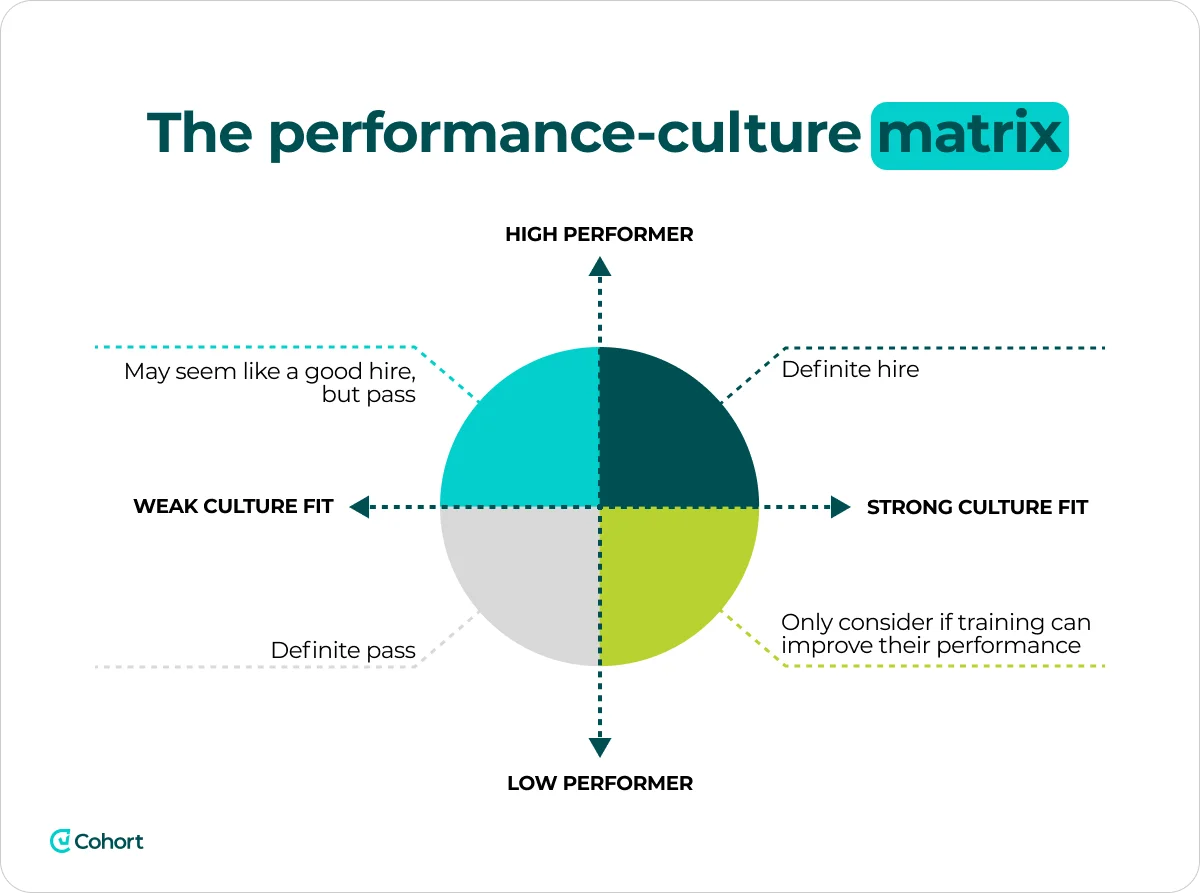
✅ How to make it work
- Define your culture clearly – Start by identifying your company’s mission, core values, and the traits that represent your workplace. A clear definition of culture makes it easier to recognize candidates who will thrive in your environment.
- Assess values and behavior, not just skills – During the interview process, evaluate soft skills and personality traits alongside technical expertise. Use behavioral interview questions or cultural assessment tools to objectively gauge alignment with your company values.
- Involve your team in the process – Include current team members in interviews or candidate evaluations. Their input helps ensure new hires complement the team dynamic and contribute to a cohesive work environment.
- Balance culture fit with diversity – Hiring for culture fit doesn’t mean hiring people who are all alike. Seek candidates who share your organization’s values while bringing diverse perspectives and backgrounds that enrich your team.
2. Leverage automation and AI tools in hiring
Recruiters spend hours sorting through resumes, scheduling interviews, and chasing candidates, often just to lose the best ones to faster-moving competitors. With shrinking talent pools and rising expectations, manual hiring simply can’t keep up.
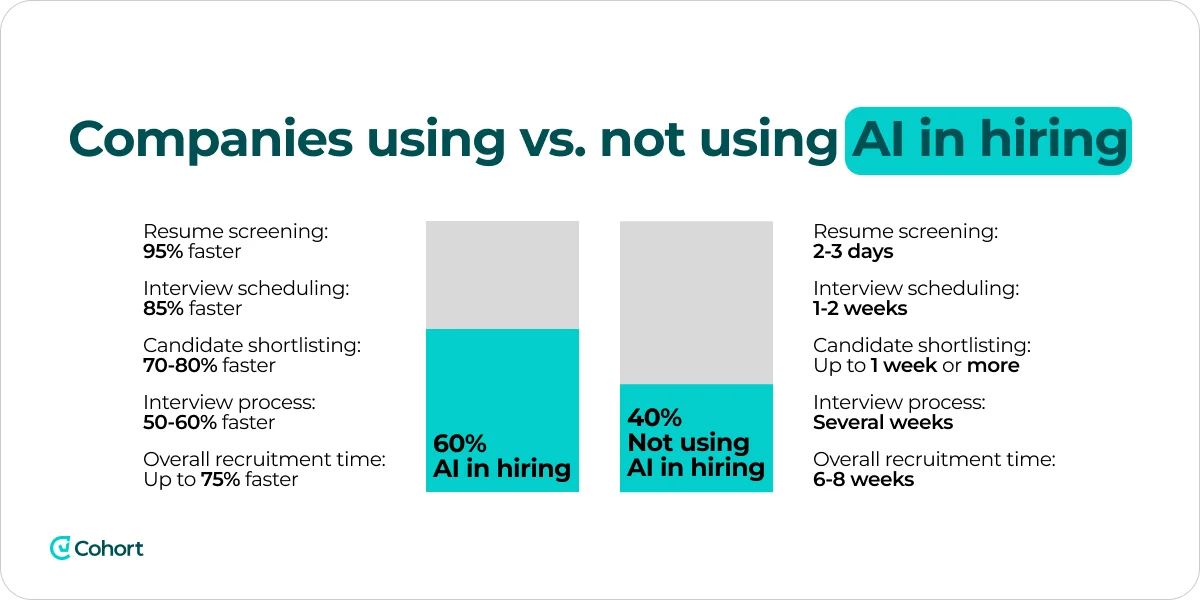
That is why nearly 47% of recruiters already use AI in their screening process, improving efficiency, reach, and the quality of their hiring decisions.
✅ How to make it work
- Use an Applicant Tracking System (ATS) – Automate resume sorting and filtering to quickly identify top candidates. AI-driven ATS platforms can assess skills, experience, and even context, helping recruiters focus on quality, not quantity.
- Adopt AI-powered screening tools – AI screening systems can analyze thousands of applications in minutes, finding the best matches based on patterns and context that humans might miss.
- Implement chatbots for candidate engagement – AI chatbots on your careers page or LinkedIn can answer FAQs, pre-screen applicants, and schedule interviews 24/7, ensuring candidates stay engaged and informed.
Companies using chatbots have seen 95% more visitor-to-lead conversions and 40% more completed job applications than those without.
- Automate scheduling and communication – AI scheduling tools can instantly match candidate and interviewer availability, cutting hiring time dramatically.
For example, one major retailer’s AI-driven “Project 24” reduced its time-to-offer from 14.5 days to just 3.5 days, giving them a key advantage in securing top talent.
- Expand and diversify your candidate pool – AI sourcing tools can identify passive candidates across professional networks. At the same time, AI writing assistants can craft inclusive job postings that attract a broader range of applicants.
A recent study shows that one company saw a 30% increase in qualified candidates after using AI to rewrite job descriptions in more inclusive terms.
💡 Pro tip
Instead of juggling separate tools for outreach, screening, engagement, and shortlisting, streamline your workflow with an all-in-one AI-powered hiring platform. This approach reduces costs, minimizes complexity, and accelerates hiring, all while improving candidate quality.
With Cohort AI, you can:
- Manage your entire hiring funnel in one place.
- Automate outreach, screening, and engagement with built-in AI agents.
- Receive pre-vetted, top candidates in as little as 3 days.
- Eliminate tool-hopping, make faster decisions, and reduce candidate drop-offs.

👉 Book a demo today secure top talents within days, not months!
3. Source talent in the right places
Recruiters who depend only on traditional job boards often miss out on highly qualified talent.
A recent study shows that 77% of recruiters use LinkedIn to find candidates, but many also source from specialized platforms like GitHub for developers, Dribbble and Behance for designers, and industry-specific forums where professionals actively showcase their skills.
✅ How to make it work
- Meet candidates where they are – Use professional and social networks to connect with active and passive talent. Engage genuinely on platforms like LinkedIn, Twitter, and even Facebook, where only 39% of recruiters currently recruit, to gain a competitive edge and expand your reach.

- Tap into employee referrals – Develop a structured referral program that encourages employees to share qualified candidates from their networks and makes participation simple and meaningful.
Research shows that while only 25% of job board hires stay longer than two years, 45% of referral hires remain for four or more.
- Explore nontraditional and diverse talent sources – Go beyond conventional hiring channels by partnering with universities, coding bootcamps, and professional associations.
Participate in hackathons, job fairs, and online meetups to connect with top talent early, identify skilled individuals in action, and expand your access to high-performing candidates.
4. Streamline the hiring process and enhance candidate experience
A slow or complex hiring process can cost you top talent. Skilled candidates often juggle multiple offers, meaning every extra day or unclear step increases the chance they’ll go elsewhere.
What the numbers reveal:
- 52% of companies admit they lose top candidates to employers with faster, more efficient hiring processes.
- 60% of candidates drop out of applications that are too long or complicated.
- 52% of job seekers have turned down job offers after experiencing a poor or disorganized recruitment process.
✅ How to make it work
- Identify and remove bottlenecks – Audit each step of your hiring funnel, from application to offer, for unnecessary delays. Shorten interview cycles, reduce wait times for feedback, and simplify forms to keep candidates engaged.
- Communicate clearly and consistently – Set expectations early about the process and timeline. Even simple automated updates like “we’re reviewing your application” can reassure candidates and reduce drop-offs.
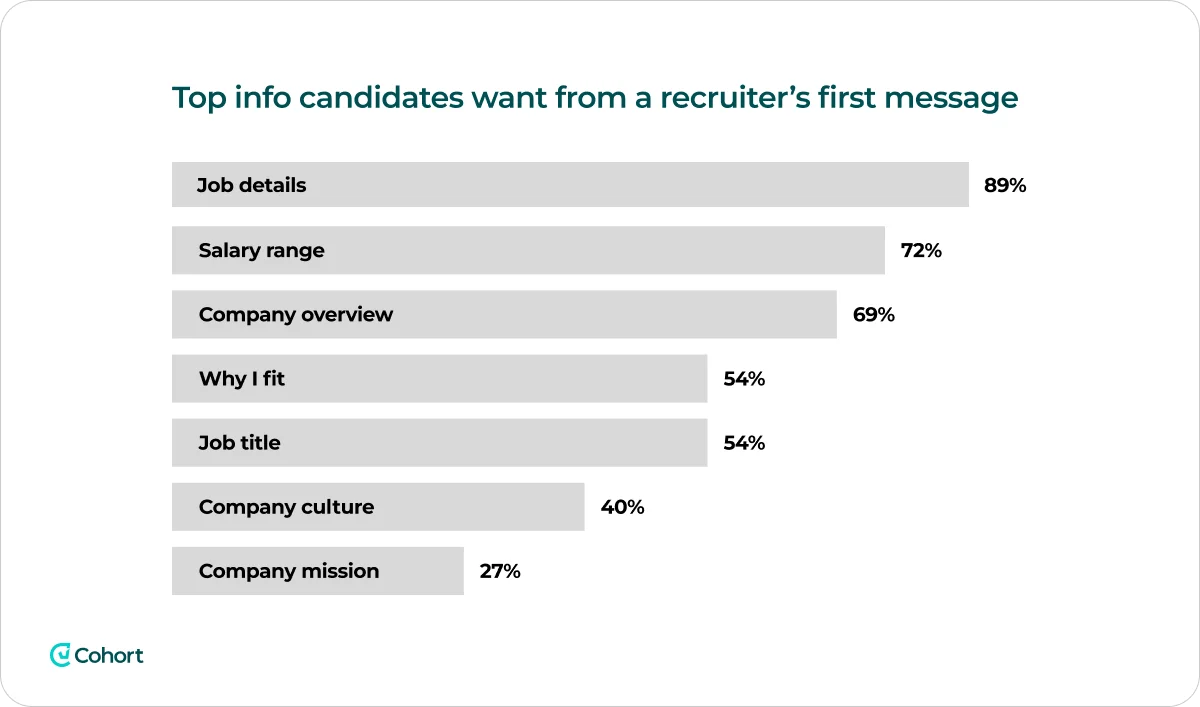
- Respect candidates’ time – Schedule interviews efficiently, avoid redundant rounds, and keep communication prompt. Candidates value a smooth, respectful experience, and speed often decides who accepts your offer.
- Personalize the experience – Add human touches like thank-you emails, warm interview greetings, and constructive feedback for those not selected. These gestures show professionalism and leave a positive lasting impression.
5. Offer flexibility
Top professionals in 2025 are drawn to workplaces that support flexibility, personal growth, and work-life balance. Remote and hybrid models have redefined how people choose where to work, making adaptability a key advantage in hiring.
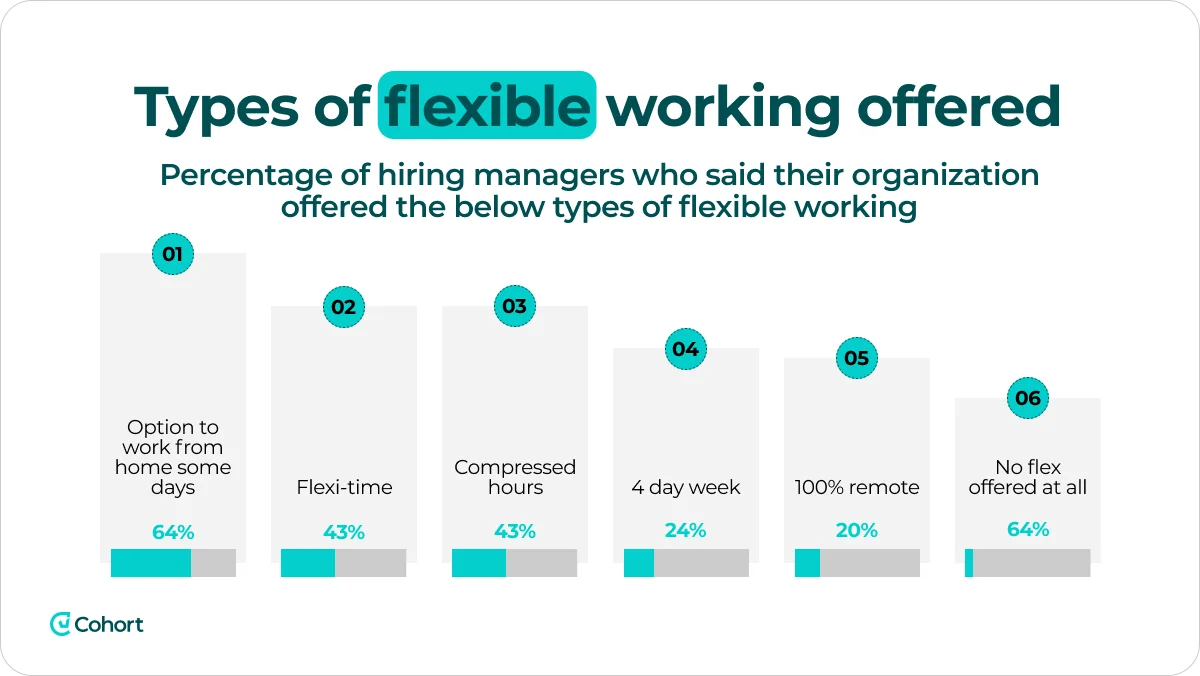
What the numbers reveal:
- 60% of applicants want flexibility in when and where they work.
- Three in four workers with remote-capable jobs currently work from home at least part-time, and 46% say they’d quit if employers took away that perk.
- Only 43% of fully remote organizations reported difficulty recruiting, compared to 83% with strict in-office policies.
✅ How to make it work
- Embrace flexible work models – Offer remote, hybrid, or flexible scheduling options. Even small adjustments, like flexible start times or four-day workweeks, can significantly widen your candidate pool.
- Promote employee growth – Invest in mentorship programs, training budgets, and clear promotion paths. Studies show that 67% of employees would stay with a company that supports career development, even if they’re unhappy in their current role.
- Reevaluate compensation and benefits – Competitive pay still matters, but pairing it with strong benefits makes a bigger impact. Highlight wellness programs, generous paid time off, parental leave, and retirement plans in your job postings and interviews.
- Showcase culture and purpose – People want to work for organizations that value balance, trust, and impact. Emphasize your company’s commitment to employee well-being and any social or community initiatives that reflect your mission.
6. Build talent pipelines & engage passive candidates
Relying only on active job seekers limits your reach, as many of the best hires aren’t even looking when you find them.
Studies show that around 73% of professionals are passive candidates: they’re not job hunting but would consider the right opportunity if it came along.
✅ How to make it work
- Build a proactive talent pipeline – Keep a curated pool of potential candidates you’ve connected with, even if there’s no open role yet.
Include past applicants, standout LinkedIn profiles, and contacts from industry events. Stay in touch through occasional updates or check-ins so they remain warm leads when new positions open.
- Highlight your Employee Value Proposition (EVP) – Passive candidates move for meaning, not necessity. According to LinkedIn’s Global Talent Trends report, 83% of passive candidates consider a new job only if the EVP is compelling.
.webp)
- Respect their time and approach – Offer discreet communication, convenient interview times, and avoid pressure. A smooth experience leaves a strong impression, even if they don’t move now.
- Make recruiting a continuous process – By maintaining relationships with passive talent, you turn hiring from a reactive task into an ongoing strategy. This steady engagement helps you access high-caliber professionals before they even hit the market.
Take your recruiting strategy to the next level with Cohort AI
Now that you know how to find and attract top talent using proven, modern recruiting strategies, it’s time to put those insights into action.
The truth is, even the best hiring playbook can fall short without the right technology to support it.
That’s where Cohort AI comes in.
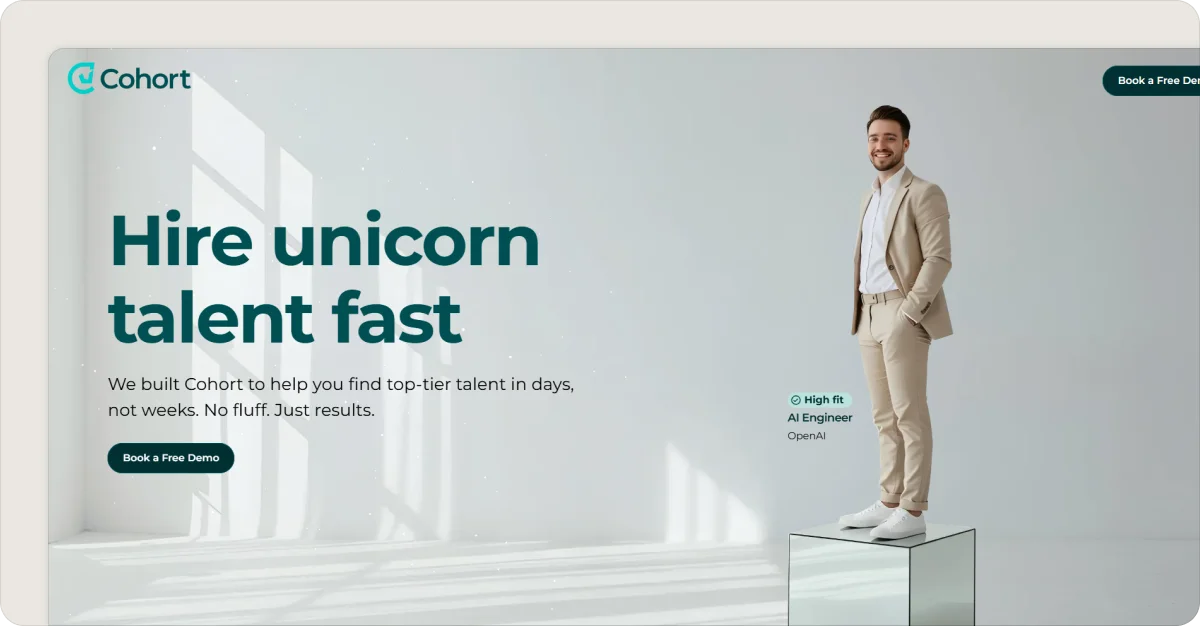
We created Cohort AI after experiencing the frustration of spending months on hiring processes that led to candidates who just didn’t fit. Now, you can get your top three vetted candidates, screened by AI and refined by human experts, in just a few days.
Our system deeply understands your role and company context, while our Talent Architects fine-tune the search to ensure every candidate is a true match. This allows you to uncover top talent and hire 40% faster, without the wasted effort.
Here is how Cohort AI can help you:
- Innovative talent sourcing – Identifies high-potential candidates through skills and demonstrated work, reducing reliance on traditional resume screening.
- Streamlined assessments – Conducts asynchronous, role-specific interviews and evaluates responses against clearly defined success criteria.
- Personalized candidate outreach – Crafts tailored communications aligned with your brand voice and job requirements to engage top talent.
- Enhanced candidate engagement – Automates follow-ups and Q&A to foster trust, improve responsiveness, and minimize drop-off.
- Intelligent candidate matching – Connects skills, behaviors, and working styles to ensure alignment based on how candidates work, not just where they’ve worked.
Book a demo today and see how Cohort AI can help your organization attract, evaluate, and hire top talent with precision!













